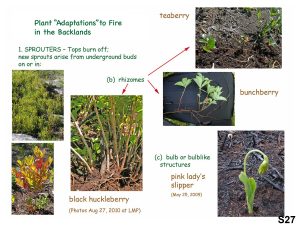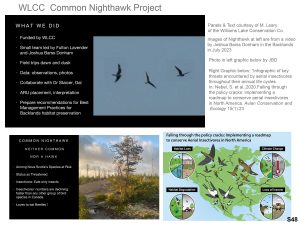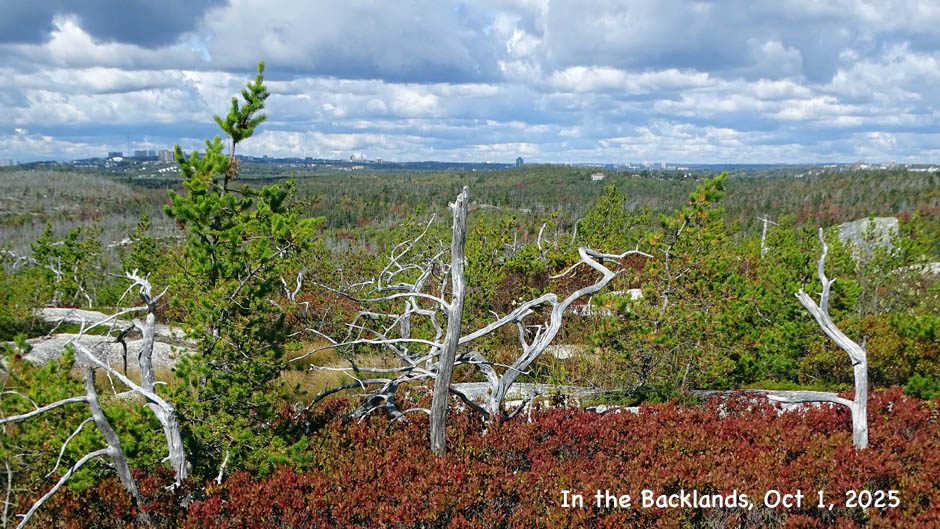
The fire-adapted, fire-dependent and fire-stimulating “Globally Rare & Nationally Unique” (and incredibly beautiful) Jack Pine-Broom Crowberry community in an area of whalebacks in the Backlands. This site was “ready to burn” in 2013 and is even more ready in 2023 – are WE ready for it to burn?
Click on images for larger versions
Yours Truly (David P) talked about Fires, Conservation and Fire Management in the Halifax Backlands in an online presentation to the Nova Scotia Wild Flora Society on Oct 29, 2023.
The presentation is available on YouTube and the slide deck is available at www.versicolor.ca/fire. Some “Useful Links” are given at the versicolor site, and the video can be downloaded from that site.
This topic has many layers, there are lots of materials and I just touch on them in the presentation. I have made the slide deck available so those interested can download it if they want to study individual slides in more detail.

“Sprouters” are one category of vascular plants adapted to repeated fire. Most of the species in the photo of Oct 31, 2009 below are sprouters.
Basically I make the case that the Backlands have exceptional ecological value (and probably this audience doesn’t need to be convinced of that), exceptional recreational value (again this audience probably doesn’t need to be convinced); but also that the Backlands are exceptionally fire prone and the ecosystems exceptionally fire adapted and fire dependent and in that regard, people may need some convincing.
The main point is one I have been pushing for some time: we need a combined Conservation/Fire Management Strategy for the Backlands. We need to address fire management AND conservation at the same time, for our own safety and to conserve these exceptional ecosystems.

Possible components of a combined Conservation/Fire Management strategy.
Click on image for large version
There are 9 sections following the introduction:
1. Fires in Canada and NS recently and historically (begins at 1 min: 57 secs)
2. The Backlands, Where, Geology, etc. (Maps) (9:20)
3. Plant Communities of the Backlands (16:34)
4. Adaptations of Backlands plants to Fire (19:15)
5. Post-Spryfield Fire Early Succession (1-2 years) (27:02)
6. Conservation and Recreational Values of the Backlands (29:32)
7. Frequency and severity of fires in the Backlands (40:02)
8. Towards a combined Conservation/Fire Management Strategy for the Backlands (43:51)
9. Discussion (48:15; end at 1:00).

In 2023, the Williams Lake Conservation Co. Nighthawk Project revealed much higher Common Nighthawk activity in the Backlands than anticipated. A Species-at-Risk, the insectiverous Common Nighthawk nests in open post-fire areas & feeds on insects that proliferate in wetlands, habitats that are juxtaposed in the Backlands.
For More on the Topic
View pages on this website under Natural History/Overviews/Fire Ecology and the subpages.
A record of news related to wildfires this past spring in NS is available at versicolor.ca/nstriad/NS Forest Fires, and there is a set of subpages that may be of interest:
– NS Gov on Wildfires
– Ecological Recovery/Fire Ecology
– FireSmart Practices
– Hammonds Plains/Tantallon fires 2023
– Shelburne Area Fire
Special Thanks to the following for help with materials:
– Jennifer Escott, Williams Lake Conservation Co., and Backlands Coalition: info on properties recently protected in the Backlands;
– James MacKinnon, Provincial Forest Fire Science Officer: NRR Fuel type map;
– Katharine Studholme, Williams Lake Conservation Co., and Backlands Coalition: info. on Species at Risk;
– Martha Leary, Williams Lake Conservation Co., and Backlands Coalition: info. & graphics related to the Nighthawk Project also special thanks to Fulton Lavender, Joshua Barss Donham & Cindy Staicer for their work on the Nighthawk Project.
– David P
Oct 26, 2023

Photo on Oct31, 2009 in the Purcells Cove Conservation Lands illustrates rapid regeneration in an area that burned on May 1, 2009. Huckleberry leaves are”fire-engine red” just before leaf-fall. Photo by Richard Beazley.
Click on image for larger version
—–
Some related posts on backlandscolition.ca
Golden Heather in flower in the Backlands 30Jun2023
And some thoughts about what’s involved in keeping it around
June 30, 2023
Shaw Wilderness Park – Camp Fire Sighted! 31July2023
PostJul 12, 2023
Fire-scarred white pines are a reminder that it’s Fire Season – especially in the Backlands (Halifax, NS) 19May2023
Post May 19, 2023
Recent fire and fire management in the New Jersey Pine Barrens: a model for the Backlands? 12Jul2022
Post, July 12, 2022.
Mapping forest fire risk in the Eastern Chebucto Peninsula Backlands
Post Apr 29, 2021
No Fires Please!
Posted on August 8, 2016
Fire hazard in the Backlands is high
Post May 3, 2016
A Rare Plant Community in the Backlands
PostFeb 13, 2014


